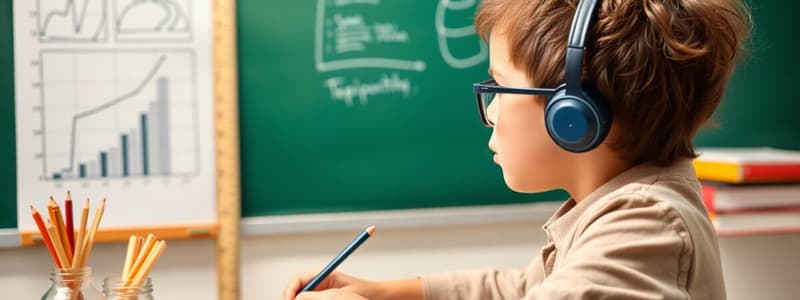Podcast
Questions and Answers
Which primary focus is emphasized for teachers within the context of measurement and evaluation?
Which primary focus is emphasized for teachers within the context of measurement and evaluation?
- Understanding the historical context of educational policies.
- Calculating complex statistical formulas.
- Managing outcomes in continuous assessment and ethical considerations. (correct)
- Memorizing different types of educational instruments.
What is the key distinction between physical and educational/psychological measurements?
What is the key distinction between physical and educational/psychological measurements?
- Educational and psychological measurements often deal with abstract concepts. (correct)
- Physical measurements are not applicable in educational settings.
- Physical measurements always require specialized equipment.
- Educational measurements are more objective than physical measurements.
How do cognitive domains of learning primarily relate to a learner's abilities?
How do cognitive domains of learning primarily relate to a learner's abilities?
- Physical coordination and motor skills.
- Emotional responses to learning environments.
- Knowledge, intellectual skills and abilities. (correct)
- Social interactions and group dynamics.
Which aspect of student development is primarily addressed by the affective domain of learning?
Which aspect of student development is primarily addressed by the affective domain of learning?
In what way does the psychomotor domain of learning influence a student's capabilities?
In what way does the psychomotor domain of learning influence a student's capabilities?
What is the fundamental role of measurement in the context of education?
What is the fundamental role of measurement in the context of education?
How does evaluation differ from measurement in assessing student performance?
How does evaluation differ from measurement in assessing student performance?
What is the primary purpose of using 'systematic procedures' in testing?
What is the primary purpose of using 'systematic procedures' in testing?
Why is comparing a test score to a standard or criteria important?
Why is comparing a test score to a standard or criteria important?
In assessing student performance, what is the significance of comparing a student’s score with those of their peers?
In assessing student performance, what is the significance of comparing a student’s score with those of their peers?
According to Chase (1978), what does measurement quantify in educational settings?
According to Chase (1978), what does measurement quantify in educational settings?
What is the systematic process of evaluation primarily focused on?
What is the systematic process of evaluation primarily focused on?
Which of the following is a way that measurement serves in a school system?
Which of the following is a way that measurement serves in a school system?
How can measurement be used to improve the efficiency of teaching methods?
How can measurement be used to improve the efficiency of teaching methods?
Evaluations may be used to determine teachers' effectiveness. What is this based on?
Evaluations may be used to determine teachers' effectiveness. What is this based on?
What is the primary role of formative evaluation in the educational process?
What is the primary role of formative evaluation in the educational process?
When is summative evaluation typically conducted in a course or unit of instruction?
When is summative evaluation typically conducted in a course or unit of instruction?
What is the main goal of placement evaluation in education?
What is the main goal of placement evaluation in education?
What does diagnostic evaluation aim to identify in students?
What does diagnostic evaluation aim to identify in students?
How does understanding the different domains of learning (cognitive, affective, and psychomotor) help teachers?
How does understanding the different domains of learning (cognitive, affective, and psychomotor) help teachers?
What is a common misconception about the cognitive domain of learning?
What is a common misconception about the cognitive domain of learning?
What is the greatest challenge in measuring the affective domain of learning?
What is the greatest challenge in measuring the affective domain of learning?
Which of the following is an example of applying measurement in education?
Which of the following is an example of applying measurement in education?
What would be considered an inappropriate application of evaluation in education?
What would be considered an inappropriate application of evaluation in education?
Why is it insufficient to only use summative evaluation in schools?
Why is it insufficient to only use summative evaluation in schools?
What type of measurement instrument can be used to measure students' attitudes towards their school?
What type of measurement instrument can be used to measure students' attitudes towards their school?
What can the outcome of evaluations allow teachers to do?
What can the outcome of evaluations allow teachers to do?
Comparing a student’s score with their peers on a test primarily provide which indicator?
Comparing a student’s score with their peers on a test primarily provide which indicator?
When considering the role of measurement and evaluation in education, what does measurement quantify according to Chase?
When considering the role of measurement and evaluation in education, what does measurement quantify according to Chase?
What is the significance of measurement in relation to teaching methods?
What is the significance of measurement in relation to teaching methods?
Measurement of student performance is often done with tests, but what is another method?
Measurement of student performance is often done with tests, but what is another method?
In education, which domain is primarily concentrated on feelings, attitudes, and emotional response during the instructions?
In education, which domain is primarily concentrated on feelings, attitudes, and emotional response during the instructions?
Which of the following assessments occur at the end of a unit or lesson in order to determine if a student should proceed to the next?
Which of the following assessments occur at the end of a unit or lesson in order to determine if a student should proceed to the next?
If a student is struggling in a particular subject, which type of assessment will establish the causes of difficulty?
If a student is struggling in a particular subject, which type of assessment will establish the causes of difficulty?
What would happen once areas of difficulties, derived form diagnostic assessments, are determined?
What would happen once areas of difficulties, derived form diagnostic assessments, are determined?
How are teachers able to monitor student learning progress during an instruction?
How are teachers able to monitor student learning progress during an instruction?
Which aspect of measurement is quantified relative to teaching methods?
Which aspect of measurement is quantified relative to teaching methods?
Which of these metrics are emphasized for teachers within the context of measurement and evaluation?
Which of these metrics are emphasized for teachers within the context of measurement and evaluation?
Flashcards
Cognitive Domain
Cognitive Domain
Knowledge and intellectual abilities of the learner, including facts, theories, and principles.
Affective Domain
Affective Domain
Deals with a student's attitudes, emotions and feelings, such as interest in learning or willingness to cooperate.
Psychomotor Domain
Psychomotor Domain
Deals with motor skills and the development of physical skills.
Measurement
Measurement
Signup and view all the flashcards
Evaluation
Evaluation
Signup and view all the flashcards
Test
Test
Signup and view all the flashcards
Formative Evaluation
Formative Evaluation
Signup and view all the flashcards
Summative Evaluation
Summative Evaluation
Signup and view all the flashcards
Placement Evaluation
Placement Evaluation
Signup and view all the flashcards
Diagnostic Evaluation
Diagnostic Evaluation
Signup and view all the flashcards
Study Notes
Introduction to Measurement and Evaluation in Education
- This unit emphasizes the importance of monitoring outcomes and acquiring relevant skills in the context of the Professional Diploma in Education (PDE).
- The unit explores measurement and evaluation, highlighting their differences across various learning domains.
- It underscores the significance of managing outcomes, continuous assessment, and ethical considerations in measurement and evaluation for teachers.
- Physical measurements differ from educational and psychological measurements, understanding this helps educators create effective measurement tools.
Categorization of Learning
- Learning is divided into three main domains: cognitive, affective, and psychomotor.
- Measurement and evaluation should consider these domains for the individual's holistic development.
Cognitive Domain
- This domain focuses on the learner's knowledge and intellectual abilities.
- It encompasses facts, theories, principles, and cognitive processes.
Affective Domain
- Deals with attitudes, feelings, and emotions related to learning.
- Includes interest in learning, class attendance, cooperation, honesty, and self-discipline.
Psychomotor Domain
- Concerns motor skills and the development of physical and manipulative abilities.
- These skills are often inherent and develop naturally, educators should understand and leverage this.
Measurement
- Measurement uses numbers to describe quantities, qualities, or frequency based on a set of values.
- For example, measuring student heights involves applying numbers to linear units (e.g., centimeters).
- Speed, time, and distance are quantified using numerical rules; speed is the ratio of distance to time.
- Mental measurement also involves rules for applying numbers to describe human performance characteristics.
Evaluation
- Evaluation assesses amounts against criteria to make value judgments.
- It determines the quality of performance, changes, or procedures.
- Criteria are needed to evaluate measurements, such as reading speed (e.g., 130 words per minute for an elementary student).
- Evaluation involves scrutinizing instructional processes based on data and benchmarks.
Test
- A test is a systematic method for comparing an individual's performance against a set standard.
- Key components include "systematic procedures" and "comparing."
- Situations must be designed to elicit behaviors, which are then observed.
- Comparing performances requires observing individuals under the same conditions, known as "Systematic Procedures".
- A test score is meaningless until it is compared, for example 75% on a verbal reasoning test needs comparison.
Bases for Comparison
- Two bases for comparison include scores of peers and criteria of minimum proficiency.
- Comparing a score against peers indicates relative status on a test.
- The second comparison ties to the minimum proficiency in the skill being assessed.
- Achieving 75% might be good compared to peers, consider primary four multiplication.
- At the end of primary four, students should complete these multiplications with 99% accuracy.
Role of Measurement and Evaluation in School System
- According to Chase (1978), measurement uses numbers to describe quantity or frequency, assigning numbers to objects and events by number.
- Measurement answers the question "how much?"
- Measurement quantifies behavior performance traits and describes them via numbers.
- Evaluation is a systematic process to determine the extent to which instructional objectives are achieved.
- It combines quantitative and qualitative descriptions of student behavior with value judgments about its worth.
Measurement Tools
- Tests are the primary tool for measuring student performance.
- Non-test techniques include observation, interviews, questionnaires, and rating scales.
- Student academic performance is measured using tests, and attitudes are measured through questionnaires.
- Measurement assesses academic progress and attitudes.
- Measurement assesses teaching method efficiency, outcomes may indicate the teaching method should be adjusted.
- Teacher efficiency and effectiveness are measured by student academic performance and attitudes.
Types of Evaluation
- Formative evaluation monitors learning progress during instruction, with the teacher asking the student questions.
- Formative evaluation provides feedback to teachers and students based on oral questions, observations, homework, etc.
- Summative evaluation occurs at the end of a course to determine if learning is complete and assign scores.
- Summative evaluation assesses mastery of learning outcomes through classroom tests, finals, and exams, and for judging student performances.
- Placement evaluation determines the appropriate placement, aligning with entry into instruction.
- Placement evaluation measures the student's pre-existing knowledge and skills, through pre-tests to ensure students success.
- Diagnostic evaluation identifies specific areas of difficulty and their causes by using simple items to complex ones.
- Diagnostic evaluation leads to adjustments in teaching methods to simplify and help easy learning.
Studying That Suits You
Use AI to generate personalized quizzes and flashcards to suit your learning preferences.




